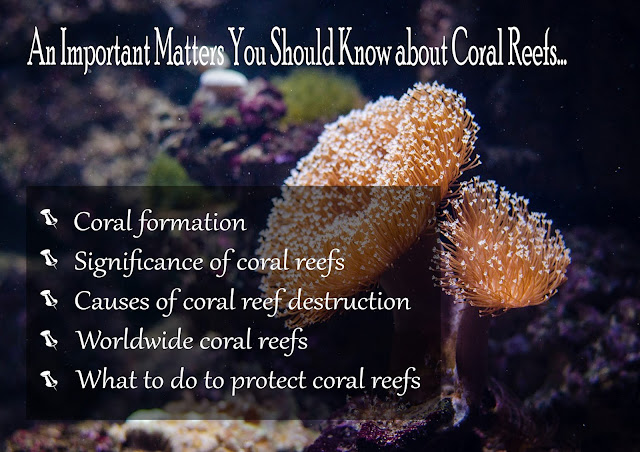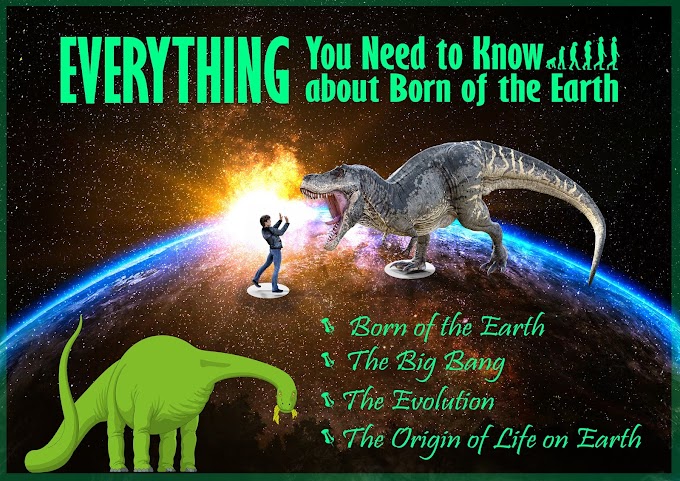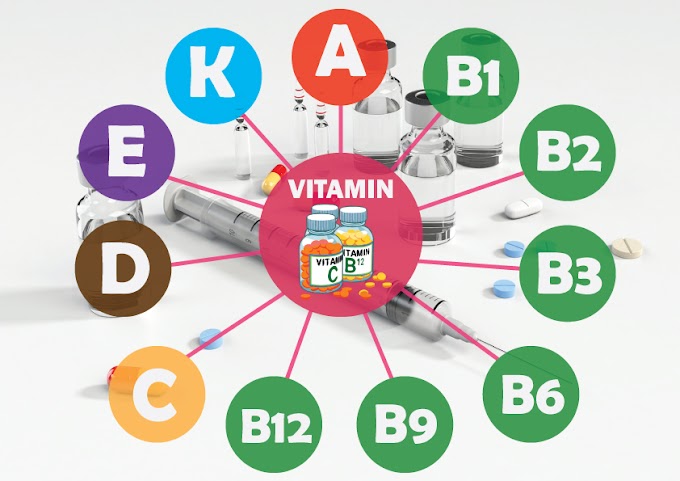 |
What Are Coral Reefs?
Coral reefs are one of nature's most beautiful aquatic systems that adorn the coastline. It is the most valuable resource in the ocean. Coral reefs are a growing species. Coral reefs have similar biodiversity to tropical rainforests. Coral reefs are also known as ocean rainforests. This is the habitat of many-coloured coral reefs. Also, due to the protection and abundance of food associated with these coral reefs, the population of various species such as fish and mollusks is very high. Therefore, it plays an important role in protecting the beach, the survival of the fishing industry and the tourism industry. Corals are divided into two main categories.
1. Hard Corals - An outer shell made of calcium carbonate.
2. Soft Corals - Slightly calcium carbonate inside.
Coral formation ;
Corals are made from an organism called 'coral polyps'. The polyp is a very soft and transparent animal. This creature resembles an inverted jellyfish. They belong to the genus Cilantarata. There is a hole in the centre of the body. It's like a belly. The receptors around the mouth carry food to the mouth. They create a calcium carbonate structure outside their body and are more active at night than during the day. If part of this calcium carbonate structure breaks down, the animal will die in a few weeks. Corals are formed by the accumulation of large numbers of such animals. Thus, thousands of such shells are deposited on rocks over a long period of time to form a coral population. The corals that are created in this way get different colours from this polyp. But polyp has no colour. This is the colour of the algae that live in the body of the polyp.
Coral and Zooxanthellae are two groups that coexist. Both of these types receive feedback from each other. This Zooxanthellae is an algae species. This Zooxanthellae is a single-celled plant species. The Zooxanthellae use solar energy to synthesize photosynthesis and produce oxygen and other nutrients. The polyp provides habitat and respiratory carbon dioxide to zooxanthellae. Zooxanthellae provide a portion of the food produced and oxygen to the Polyp.
The corals created by the combination of all these have been growing slowly for thousands of years. Some corals grow as small as 15cm per year. But coral does not grow on every coast. It requires a special ecosystem suitable for it.
1. The temperature of the ocean water should be between 2 and 24 degrees Celsius.
2. The salinity range of ocean water should be between 30% - 35%.
3. Sunlight should be well below the ocean floor.
4. There should be a clear water level with fewer sea waves.
If the temperature of the ocean changes even slightly at once, it can be harmful to the corals. Coral reefs grow only up to 50m below sea level. This is because sunlight does not travel through water for more than 50 meters.
Corals ;
Corals are divided into 3 parts according to their location.
1. Fringing Reefs
These are located in shallow ocean areas very close to the coast. There are two types of Fringing Reefs. The first is the front part or interface. These grow very well as they face the ocean. This is because these corals receive good water flow because they do not deposit silt.
The other type of rock is the flat coral reef. These grow near the land and take a flat shape.
Corals grow very slowly during warmer climates. This is because too much sunlight causes water to evaporate and become saltier.
2. Barrier Reefs
These are designed as a barrier between the coast and the sea. The interface and the flat surface can be seen in the Fringing Reef as well as in the barrier reefs. But the barriers are far from land. The peculiarity of these reefs is the formation of a deep and wide lagoon in the region between the flat reef and the shore of the barrier reef. This lagoon grows very well coral and grows very beautifully and vigorously. The part of the lagoon that forms is called the Inner Reef. The largest barrier coral reef in the world is located in Australia. It is called the Great Barrier Reef.
3. Atolls Reefs
These are located in the oceans far from the continents. These are called small coral islands. The corals are shaped like a circle. These are formed by the growth of coral around the top of a submerged volcano or around the tops of submerged mountains in the ocean. These Atolls Reefs form small islands. These corals are home to small micro-organisms such as crustaceans, shells and conchs, and sponges.
Some of the coral species we see in the ocean ;
 |
| Picture of Coral Reef |
* Black Coral
* Acropora
* Astreopora
* Poritidae
* Agaricidae
* Gorgonian
* Pocilloporidae
* Cup Coral
* Mussidae
* Meandrinidae
* Anatomy
* Fungilldae
* Montipora
* Pectinidea
* Oculinidea
* Variable Soft Coral
Coral Reef Fish Species ;
 |
| Fish in Coral Reefs |
* Parrot Fish
* Angel Fish
* Grunt
* Snapper
* Goat Fish
* barracud
* Scorpion Fish
Why are Coral Reefs Important?
Significance of coral reefs ;
* Acts as a barrier to reduce marine erosion.
* Being an important marine system that provides food and habitat for various fish and aquatic life
* To make fish and living organisms suitable breeding places.
* Importance as suitable areas for fishing.
* Being an environment that attracts tourists.
* Helping to create islands.
* Slowing down the speed of fast ocean currents.
* Importance for lime production.
* Important for the production of various medicines.
Causes of coral reef destruction ;
The main causes of this coral reef destruction are as follows.
1. Demand for animals such as limestone quarrying and ornamental fish
With the increasing population and the increasing demand for limestone for construction, the coral reefs have been largely destroyed due to excessive limestone breaking. Coral reefs can also be damaged by trying to catch ornamental fish and ornamental animals such as oysters.
2. Excessive fishing and the use of unfavourable methods for fishing.
The destruction of coral reefs by large nets used by fishermen to catch more fish is very high. The other dangerous method is to put dynamite. Corals also vibrate when dynamite explodes. Even a very large layer of coral is destroyed by such a shock.
3. Water pollution.
The coral reefs are also destroyed by the effluent from tourist hotels and other places.
By adding burned fuel to the ocean by watercrafts such as boats, Submarines.
By anchoring. Also, coral reefs are damaged by divers and bathers.
4. Silt deposits in coral reefs.
Due to flooding caused by the clearing of river basins, the silt that builds up in the rivers is washed away into the sea and binds around the coral reefs. This threatens the survival of the corals.
5. Conditions such as storms and tsunamis.
Coral reefs can also be damaged by strong waves and rough seas.
6. Threats of predators and the spread of predatory epidemics.
Coral reefs can also be destroyed by biological factors, such as predators. For example, eating the polyps on coral reefs by starfish.
7. Diseases of coral reefs and coral bleaching.
Coral bleaching is caused by the high temperature of the seawater and the increase in sunlight (ultraviolet rays). That is, they lose their colour. This is due to the lack of zooxanthellae plants to feed the polyp. With this prolonged stay, this polyp dies. Also, coral reefs can be destroyed by diseases.
Worldwide coral reefs ;
 |
World-famous coral reef ;
 |
| Great Barrier Reef |
* Belize Barrier Reef - The world's second-largest coral reef system, extending from southern Quintanaro, Mexico, down the Belize Coast to the island of Honduras.
* Red Sea coral reefs off the coast of Egypt to Saudi Arabia.
* Puli Ridge - The deepest photosynthetic coral reef in Florida.
* New Caldney Barrier - The second-largest double barrier reef in the world, about 1,500 km long.
What to do to protect coral reefs ;
* Minimizing the amount of dirty water that accumulates in the sea along rivers and canals.
* Preventing oil spills to the sea from ships and pipelines.
* Stopping methods harmful to corals used in the fishing industry.
* stop getting live coral for the lime industry.
* To make people aware of the value of coral reefs.
* Proper enforcement of regulations imposed to protect coral reefs.
Click here to read another article about Nanotechnology.
Click here to read about Born of the Earth.










0 Comments
Hi, thanks for joining our site. You can share ideas about our website and the improvements that should be made.